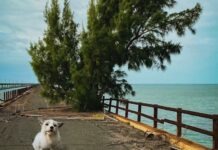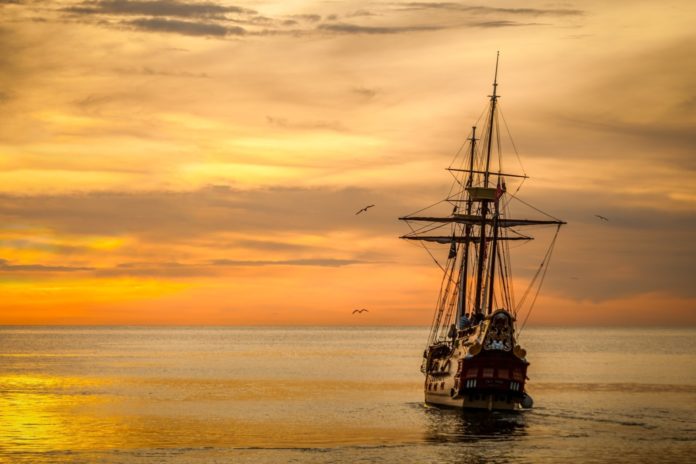Black Caesar’s pirate story spans three centuries. What every Black Caesar story has in common, however, is a pirate lair on Elliott Key. Usually, he is either an African chieftain who joined Blackbeard’s crew or an escaped Haitian slave who joined up with Southwest Florida’s legendary pirate, Jose Gaspar.
Other men have been labeled with the Black Caesar moniker. The first known reference to him sees the future pirate arriving on Elliott Key more than 100 years before the African chieftain, who arrived nearly 100 years before the escaped Haitian slave. This one-of-a-kind Black Caesar tale, written by Bruce Henry, a staff writer for the Miami Daily News, appeared in the April 5, 1936, edition of the newspaper. It is a doozy.
According to Henry, a segment of the local Miami historians believed the pirate was the descendent of the Portuguese naval officer Joao de Castro, who was born in Lisbon on Feb. 7, 1500, and died on June 6, 1548. The story began in the late 16th Century when a Spanish man-o-war attempted to navigate the Straits of Florida. Among other commodities on the vessel was human cargo – including the descendant of Castro.
The captain sailed right into a gale. Hurricane-force winds blew the ship off course and drove it against the stony corals of the reef. As they did, waves pounded the hull and crashed over the decks with white, foamy furor until the wood began to splinter, crack and break into pieces.
Not every person on board survived the hurricane, the shipwreck and, in cases, the shackles of slavery. A small group, however, lived through all three. They washed ashore in the Northern Keys – at Elliott Key. After recovering from their ordeal, they banded together and worked to salvage bits and pieces of the wreck, including wood, sails, rigging and barrels of fresh water.
One of the survivors who escaped the shackles was described as having “unusual intelligence”. He asserted his leadership and rose to be their leader. According to the lone account revealing this version of events, the survivors managed to salvage enough materials to create a primitive campsite and a vessel equipped with a mast, rigging and sails. It was not used to escape the island. Instead, the Portuguese leader led his fellow survivors into a life of piracy from their Elliott Key lair. He became known as Black Caesar.
Henry wrote in the Miami Daily News article that the pirate led “a colony of pirates and captives who looked up to him as an emperor; serving either through admiration or fear.”
Henry also wrote that Black Caesar “set a record for murder, torture, wanton destruction and thievery that even better-known pirates like Edward Teach, Sir Henry Morgan, Jean LaFitts [sic] and Captain Kidd could not equal. It is said of Black Caesar when his men had captured a ship carrying a particularly rich cargo, he would order 10 days of feasting and celebration, and personally lead the orgy of drinking and lust. He had captives roasted over slow fires for his amusement, and his harem is said to have once contained 100 young women.”
For those individuals intent on acts of piracy, Elliott Key provided excellent access to prime hunting grounds. A natural channel ran between the deeper waters offshore and the pass separating the pirate lair at Elliott Key from the next island along the chain, Old Rhodes Key. The channel was the conduit through which Black Caesar and his crew accessed vulnerable ships attempting to navigate the treacherous Straits of Florida.
What Black Caesar recognized, as would every Black Caesar who followed in his footsteps, was that the low-lying nature of the island was unable to hide the telltale sign of his mast. For wary captains navigating the pirate-rich Straits of Florida, sailing ships hiding behind an island all but advertised, “Hey, pirates here!”
Understanding the nature of his handicap, Black Caesar ordered a series of steps carved into the coral rock at the edge of the island. The chiseled steps led 9 feet below the channel’s surface. There, 9 feet below the surface, the pirate ordered an iron ring to be hammered down into the limestone substrate. The ring solved the problem of the pirate mast sticking up from behind the tree line of the island’s sub-tropical hammock.
Henry suggests in his newspaper story that the pirates ran a line through the ring to keel the ship over so that the mast was no longer visible from the shipping lanes. He wrote: “By caulking the decks and hatchways of his war vessel he could have run a rope through the eyebolt, fastened the other end to the ship’s mast, and used the leverage thus obtained to pull the boat to its side … effectively hiding it from passing vessels in the ocean beyond.”
What became of the pirate and his crew was not revealed in this legendary Black Caesar tale. It should be noted that the details of this story are eerily similar to every other Black Caesar story. A peek into its veracity becomes apparent when Henry suggests that Parson Jones, a legend in the Northern Keys, was a descendent of Black Caesar.
While the story of Israel “Parson” Jones is one of the great rags to riches stories of the Florida Keys, it is abundantly clear that he was in no way linked to an Elliott Key pirate. The Parson’s story, “Keeping up with the Joneses”, can be found in my new book, “Florida Keys History with Brad Bertelli, Volume 1.” Feel free to pick up a copy and support my efforts to share the histories of this amazing chain of islands.























